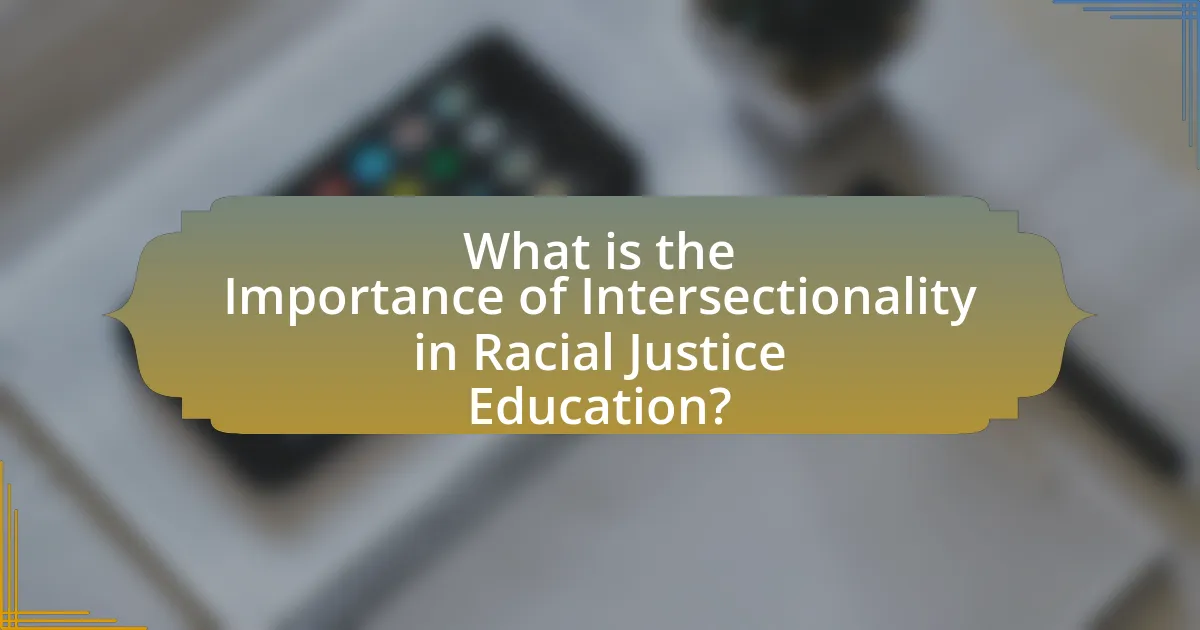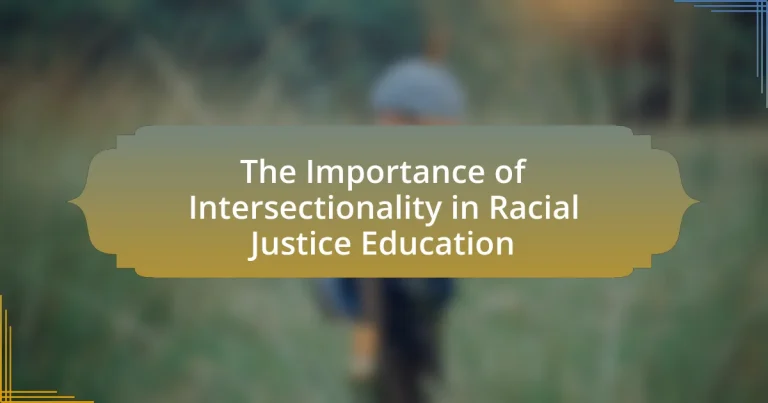Intersectionality is a critical framework in racial justice education that examines how overlapping social identities—such as race, gender, class, and sexuality—interact to shape individual experiences of oppression and privilege. The article emphasizes the importance of incorporating intersectionality into educational curricula to address systemic inequalities effectively and to recognize the unique challenges faced by marginalized groups. Key principles of intersectionality, its distinction from traditional racial justice approaches, and its implications for educators are discussed, along with strategies for implementation and assessment. By fostering an understanding of intersectionality, educators can create more inclusive learning environments that promote equity and social justice.

What is the Importance of Intersectionality in Racial Justice Education?
Intersectionality is crucial in racial justice education because it recognizes how various social identities, such as race, gender, class, and sexuality, intersect to create unique experiences of oppression and privilege. This framework allows educators to address the complexities of systemic inequality, ensuring that racial justice initiatives are inclusive and effective. For instance, Kimberlé Crenshaw, who coined the term “intersectionality,” highlighted how Black women face discrimination that is not solely based on race or gender but on the combination of both, which is often overlooked in traditional racial justice discussions. By incorporating intersectionality, racial justice education can better equip individuals to understand and combat the multifaceted nature of discrimination, leading to more comprehensive and equitable solutions.
How does intersectionality influence racial justice education?
Intersectionality influences racial justice education by highlighting the interconnectedness of various social identities, such as race, gender, class, and sexuality, which shape individuals’ experiences of oppression and privilege. This framework allows educators to address the complexities of systemic inequality, ensuring that racial justice education is inclusive and reflective of diverse perspectives. For instance, Kimberlé Crenshaw, who coined the term “intersectionality,” emphasizes that understanding how multiple identities intersect is crucial for developing effective strategies to combat discrimination. By incorporating intersectionality into racial justice education, curricula can better prepare students to recognize and challenge the multifaceted nature of social injustices, ultimately fostering a more equitable society.
What are the key principles of intersectionality?
The key principles of intersectionality include the recognition that individuals experience overlapping social identities, which can lead to unique forms of discrimination and privilege. This framework, developed by Kimberlé Crenshaw, emphasizes that social categories such as race, gender, class, and sexuality do not exist independently but interact to shape individual experiences. For instance, a Black woman may face both racial and gender discrimination simultaneously, which cannot be understood by examining race or gender in isolation. This principle is supported by research indicating that marginalized groups often face compounded disadvantages, highlighting the necessity of an intersectional approach in addressing social justice issues.
How does intersectionality differ from traditional approaches to racial justice?
Intersectionality differs from traditional approaches to racial justice by emphasizing the interconnectedness of various social identities and systems of oppression. Traditional racial justice frameworks often focus primarily on race as a singular axis of identity, neglecting how factors such as gender, class, sexuality, and ability intersect to shape individual experiences of discrimination. For example, Kimberlé Crenshaw, who coined the term “intersectionality,” highlighted how Black women face unique challenges that are not addressed by racial justice efforts that only consider race or gender in isolation. This approach recognizes that individuals experience multiple, overlapping forms of discrimination, which necessitates a more nuanced understanding of social justice that traditional models often overlook.
Why is intersectionality essential for understanding systemic inequalities?
Intersectionality is essential for understanding systemic inequalities because it reveals how various social identities, such as race, gender, class, and sexuality, intersect to create unique experiences of oppression and privilege. This framework allows for a comprehensive analysis of how systemic structures, like racism and sexism, do not operate independently but rather interact to exacerbate inequalities. For instance, Black women face discrimination that is distinct from that experienced by white women or Black men, highlighting the necessity of considering multiple identities in discussions of social justice. Research by Kimberlé Crenshaw, who coined the term “intersectionality,” emphasizes that failing to account for these overlapping identities can lead to incomplete understandings of systemic issues and ineffective solutions.
What role does intersectionality play in identifying marginalized groups?
Intersectionality plays a crucial role in identifying marginalized groups by recognizing that individuals experience multiple, overlapping social identities that contribute to their unique experiences of oppression and privilege. This framework allows for a more nuanced understanding of how factors such as race, gender, class, sexuality, and ability intersect to shape the lived realities of individuals. For instance, a study by Crenshaw (1989) highlighted how Black women face discrimination that is distinct from that experienced by either Black men or white women, illustrating the necessity of an intersectional approach in addressing the complexities of social justice. By employing intersectionality, educators and activists can better identify and address the specific needs and challenges faced by diverse marginalized communities, leading to more effective advocacy and policy-making.
How does intersectionality help in addressing multiple forms of discrimination?
Intersectionality helps in addressing multiple forms of discrimination by recognizing that individuals experience overlapping social identities, which can lead to unique and compounded forms of oppression. This framework allows for a more nuanced understanding of how various factors such as race, gender, class, and sexuality interact to shape an individual’s experiences and challenges. For example, a study by Crenshaw (1989) highlighted how Black women face discrimination that is not solely based on race or gender but is a combination of both, leading to specific barriers that are often overlooked in traditional analyses of discrimination. By applying an intersectional lens, educators and policymakers can develop targeted strategies that address these complex realities, ultimately fostering a more inclusive and equitable environment.
What are the implications of intersectionality for educators?
Intersectionality implies that educators must recognize and address the multiple, overlapping identities of their students, which can influence their experiences and challenges in the educational environment. This understanding allows educators to create more inclusive curricula and teaching strategies that reflect the diverse backgrounds of their students, thereby promoting equity in education. Research by Crenshaw (1989) highlights how individuals with intersecting identities, such as race, gender, and socioeconomic status, face unique forms of discrimination and disadvantage. By applying an intersectional lens, educators can better support marginalized students, leading to improved academic outcomes and a more equitable learning environment.
How can educators incorporate intersectionality into their curricula?
Educators can incorporate intersectionality into their curricula by integrating diverse perspectives and experiences that reflect the complexities of identity, such as race, gender, class, and sexuality. This approach can be achieved through the inclusion of texts and materials that highlight the voices of marginalized groups, facilitating discussions that explore how various forms of oppression intersect. For instance, research by Crenshaw (1989) emphasizes the necessity of understanding how overlapping identities affect individuals’ experiences with discrimination, which supports the argument for a curriculum that acknowledges and addresses these intersections. By employing case studies, collaborative projects, and critical reflection, educators can create an inclusive learning environment that fosters awareness and understanding of intersectionality in the context of racial justice.
What challenges do educators face when teaching intersectionality?
Educators face several challenges when teaching intersectionality, primarily due to its complexity and the diverse backgrounds of students. The multifaceted nature of intersectionality requires educators to navigate various social identities, such as race, gender, class, and sexuality, which can lead to misunderstandings or resistance among students. Additionally, educators may encounter a lack of resources or training on how to effectively teach intersectionality, making it difficult to convey its significance in racial justice education. Research indicates that without proper support, educators may struggle to create inclusive curricula that address the nuanced experiences of marginalized groups, ultimately hindering students’ understanding of systemic inequalities.
How can intersectionality enhance community engagement in racial justice education?
Intersectionality enhances community engagement in racial justice education by recognizing and addressing the diverse identities and experiences within marginalized groups. This approach fosters a more inclusive dialogue, allowing individuals to share their unique perspectives and challenges, which can lead to a deeper understanding of systemic inequalities. For instance, research by Crenshaw (1989) highlights how overlapping social identities, such as race, gender, and class, shape individual experiences of discrimination. By incorporating intersectionality into educational frameworks, community programs can better tailor their initiatives to meet the specific needs of various groups, ultimately increasing participation and collaboration in racial justice efforts.
What strategies can be employed to promote intersectional awareness in educational settings?
To promote intersectional awareness in educational settings, educators can implement inclusive curricula that reflect diverse perspectives and experiences. This approach involves integrating materials that highlight the interconnectedness of race, gender, class, and other identities, fostering a comprehensive understanding of social justice issues. Research indicates that when students engage with diverse narratives, they develop critical thinking skills and empathy, which are essential for addressing systemic inequalities. For instance, a study by Crenshaw (1989) emphasizes the necessity of recognizing overlapping social identities to fully understand the complexities of discrimination. Additionally, facilitating open discussions and workshops on intersectionality can empower students to share their experiences and learn from one another, further enhancing awareness and solidarity within the educational community.
What are the best practices for implementing intersectionality in racial justice education?
The best practices for implementing intersectionality in racial justice education include integrating diverse perspectives, fostering critical discussions, and utilizing inclusive curricula. Integrating diverse perspectives ensures that the experiences of various racial and social groups are represented, which is essential for understanding the complexities of identity. Fostering critical discussions encourages students to engage with and analyze the intersections of race, gender, class, and other identities, promoting deeper comprehension of systemic inequalities. Utilizing inclusive curricula that reflect the histories and contributions of marginalized communities helps to validate their experiences and challenges dominant narratives. Research by Crenshaw (1989) highlights the necessity of recognizing overlapping social identities to address the unique challenges faced by individuals at these intersections, reinforcing the importance of these practices in educational settings.
How can educators assess the effectiveness of intersectional approaches?
Educators can assess the effectiveness of intersectional approaches by utilizing qualitative and quantitative evaluation methods, including surveys, focus groups, and academic performance metrics. These methods allow educators to gather data on student engagement, understanding, and outcomes related to intersectional content. For instance, a study by Crenshaw (1989) highlights the necessity of considering multiple identities in educational settings, demonstrating that intersectional approaches can lead to improved student experiences and academic success. By analyzing this data, educators can determine the impact of intersectional strategies on diverse student populations, ensuring that educational practices are inclusive and effective.
What resources are available for educators to learn about intersectionality?
Educators can access various resources to learn about intersectionality, including academic journals, online courses, and books. For instance, the journal “Intersectionality” publishes peer-reviewed articles that explore the complexities of identity and social justice. Online platforms like Coursera and edX offer courses on intersectionality and social justice, often created by reputable universities. Additionally, books such as “Intersectionality” by Kimberlé Crenshaw and “Sister Outsider” by Audre Lorde provide foundational knowledge and critical perspectives on the topic. These resources are essential for educators aiming to integrate intersectionality into their teaching practices effectively.


